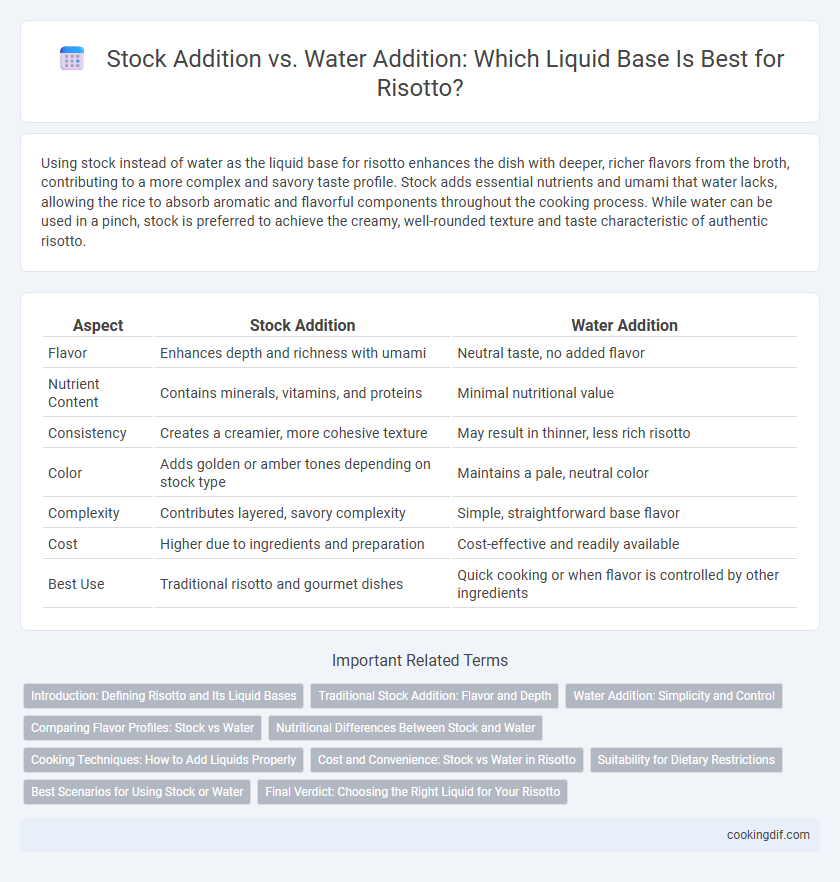Using stock instead of water as the liquid base for risotto enhances the dish with deeper, richer flavors from the broth, contributing to a more complex and savory taste profile. Stock adds essential nutrients and umami that water lacks, allowing the rice to absorb aromatic and flavorful components throughout the cooking process. While water can be used in a pinch, stock is preferred to achieve the creamy, well-rounded texture and taste characteristic of authentic risotto.
Table of Comparison
| Aspect | Stock Addition | Water Addition |
|---|---|---|
| Flavor | Enhances depth and richness with umami | Neutral taste, no added flavor |
| Nutrient Content | Contains minerals, vitamins, and proteins | Minimal nutritional value |
| Consistency | Creates a creamier, more cohesive texture | May result in thinner, less rich risotto |
| Color | Adds golden or amber tones depending on stock type | Maintains a pale, neutral color |
| Complexity | Contributes layered, savory complexity | Simple, straightforward base flavor |
| Cost | Higher due to ingredients and preparation | Cost-effective and readily available |
| Best Use | Traditional risotto and gourmet dishes | Quick cooking or when flavor is controlled by other ingredients |
Introduction: Defining Risotto and Its Liquid Bases
Risotto, a classic Italian dish, relies on gradually adding hot liquid to Arborio rice to achieve its creamy texture. Stock, typically made from meat, vegetables, or seafood, imparts depth and rich flavor, enhancing the overall taste profile. Using water instead results in a milder flavor, often requiring additional seasoning to compensate for the lack of natural umami found in traditional stocks.
Traditional Stock Addition: Flavor and Depth
Traditional stock addition in risotto enhances flavor and depth by infusing the dish with rich, savory umami compounds derived from simmered bones, vegetables, and herbs. The carefully crafted stock contributes essential nutrients and collagen, resulting in a creamy texture and complex taste profile that water cannot replicate. Using homemade or high-quality stock elevates the overall sensory experience, creating a more authentic and satisfying risotto.
Water Addition: Simplicity and Control
Water addition in risotto preparation provides simplicity and precise control over the cooking process, allowing chefs to regulate the starch release for the desired creamy texture. Unlike stock, water is neutral in flavor, making it ideal for highlighting the wine and main ingredients in the dish. This straightforward approach reduces complexity, helping maintain consistent moisture levels and preventing overpowering tastes.
Comparing Flavor Profiles: Stock vs Water
Using stock as the liquid base in risotto enhances flavor complexity by infusing rich, savory, and umami notes derived from simmered meat, vegetables, and herbs, creating a deeper, more robust taste profile. Water, by contrast, yields a more neutral, subtle backdrop that allows the primary ingredients like cheese and mushrooms to take prominence but risks producing a blander final dish. Chefs often prioritize stock for its ability to layer flavors and elevate the overall sensory experience of risotto.
Nutritional Differences Between Stock and Water
Using stock instead of water as the liquid base in risotto significantly enhances the dish's nutritional profile by adding essential vitamins, minerals, and amino acids derived from meat, vegetables, or seafood used in the stock preparation. Stock contributes higher levels of protein, collagen, and electrolytes such as potassium and sodium, which are absent in plain water, thereby improving both the flavor complexity and nutritional value of the risotto. Water, though calorie-free, lacks these nutrients and bioactive compounds, making stock the superior choice for a nutrient-enriched and flavorful risotto.
Cooking Techniques: How to Add Liquids Properly
Using stock instead of water as the liquid base in risotto enhances flavor complexity and depth, contributing to a richer final dish. Properly adding liquids involves gradually incorporating hot stock in small increments, allowing the rice to absorb the liquid evenly and release starch for a creamy texture. Maintaining a consistent stirring technique while slowly adding stock ensures optimal texture and prevents clumping or uneven cooking.
Cost and Convenience: Stock vs Water in Risotto
Using stock instead of water in risotto significantly enhances flavor, but it increases costs due to the price of broth ingredients or pre-made stock. Water offers a cost-effective, convenient alternative with no additional expense or preparation time, making it ideal for quick meals or budget-conscious cooking. However, stock's richer taste can justify the extra expense and effort for more refined dishes.
Suitability for Dietary Restrictions
Using stock as the liquid base in risotto provides enhanced flavor and essential nutrients, making it a preferred choice for those who can tolerate sodium and animal-derived ingredients. Water, being neutral and free of allergens or additives, suits individuals with strict dietary restrictions such as low-sodium diets, vegan, or allergen-free requirements. Carefully selecting a stock that aligns with dietary needs, like vegetable stock for vegans or low-sodium options for hypertensive patients, optimizes both taste and compliance.
Best Scenarios for Using Stock or Water
Using stock as the liquid base in risotto enriches the dish with deep, layered flavors, making it ideal for recipes featuring mushrooms, seafood, or aged cheeses where complexity is desired. Water is best suited for lighter risottos or when ingredients already provide substantial flavor, such as fresh vegetables or delicate herbs, ensuring a clean, subtle taste. Professional chefs often prefer homemade chicken or vegetable stock to enhance umami while home cooks might choose water for a neutral base to highlight other ingredients.
Final Verdict: Choosing the Right Liquid for Your Risotto
Using stock instead of water as the liquid base for risotto enhances the dish's depth of flavor and richness, providing essential umami notes and savory complexity. Stock, whether chicken, vegetable, or seafood, contributes nutrients and gelatin that improve the risotto's creamy texture and mouthfeel. Water can be used in a pinch but lacks these flavor elements, making stock the superior choice for an authentic and satisfying risotto experience.
Stock addition vs water addition for liquid base Infographic

 cookingdif.com
cookingdif.com